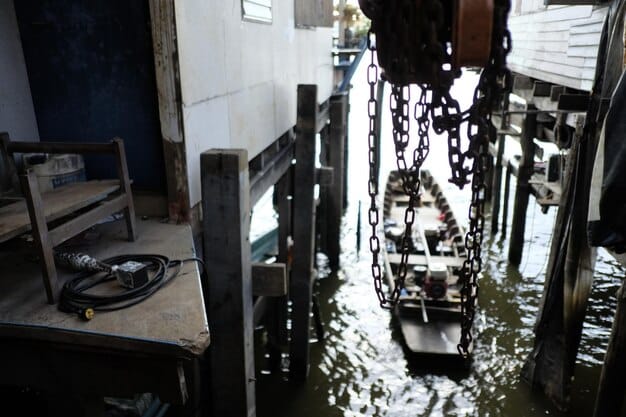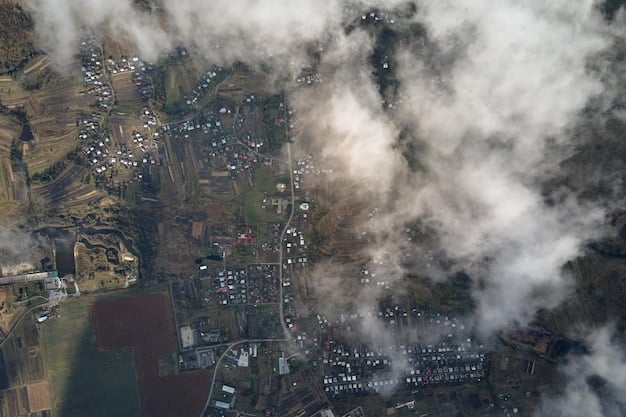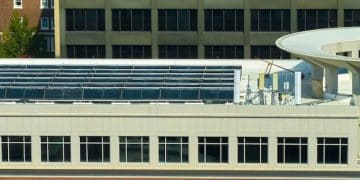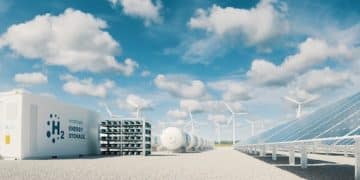Climate Change and Tech: How Infrastructure Faces the Heat

Climate change significantly impacts technology infrastructure by causing physical damage from extreme weather, increasing energy consumption for cooling, and disrupting supply chains, necessitating urgent adaptation and mitigation strategies.
The accelerating pace of climate change poses unprecedented challenges to various sectors, and the technology infrastructure, the backbone of our digital world, is no exception. Understanding the impact of climate change on technology infrastructure is ever more crucial as we depend more and more on technology.
Climate Change: An Existential Threat to Tech
Climate change, driven by increasing greenhouse gas emissions, is no longer a distant threat but a present reality. Its effects, ranging from rising temperatures and extreme weather events to sea-level rise, are already palpable across the globe. The technological infrastructure, which underpins every sector from communication and finance to healthcare and transportation, is particularly vulnerable.
The Rising Tide of Risks
The risks posed by climate change to technology infrastructure are multifaceted and interconnected. Physical damage from extreme weather events is perhaps the most immediate and visible threat. Rising temperatures increase energy consumption for cooling, disrupting supply chains, and more.
- Extreme Weather Events: Hurricanes, floods, and wildfires can directly damage data centers, communication networks, and power grids, leading to service outages and data loss.
- Rising Temperatures: Elevated temperatures increase the demand for cooling in data centers, straining energy resources and potentially leading to equipment failure.
- Sea-Level Rise: Coastal infrastructure, including submarine cables and data centers, faces inundation and corrosion from rising sea levels, threatening global connectivity.
Climate change poses a significant, multifaceted threat to the global infrastructure that our society has come to depend on. The only way to properly prepare for the future is to address these issues head-on.

Physical Vulnerabilities of Tech Infrastructure
The physical infrastructure that supports our digital world is inherently vulnerable to the impacts of climate change. Data centers, communication networks, and power grids are all at risk from extreme weather events, rising temperatures, and sea-level rise. These vulnerabilities can lead to service outages, data loss, and significant economic disruption.
Data Centers: A Hotspot for Climate Risks
Data centers, the heart of the digital economy, are energy-intensive facilities that require continuous cooling to prevent equipment failure. Rising temperatures exacerbate this need, increasing energy consumption and operational costs. In addition, data centers located in coastal areas are vulnerable to flooding and sea-level rise.
Communication Networks: The Fragile Web
Communication networks, including fiber optic cables, cell towers, and satellite infrastructure, are susceptible to damage from extreme weather events such as hurricanes, tornadoes, and ice storms. Power outages can also disrupt these networks, leading to communication breakdowns and hindering emergency response efforts.
Physical vulnerabilities of our tech infrastructure are ever-present. Understanding data center related vulnerabilities can assist in making more informed decisions regarding how we operate these core parts of modern life.
Energy Consumption and Carbon Footprint
The technology industry is a significant consumer of energy, contributing substantially to global greenhouse gas emissions. The production and operation of data centers, devices, and networks all require vast amounts of electricity. As climate change intensifies, the need to reduce the energy consumption and carbon footprint of the tech industry becomes even more critical.

Renewable Energy Transition
Transitioning to renewable energy sources is essential for reducing the carbon footprint of the tech industry. Solar, wind, and other renewable technologies offer clean, sustainable alternatives to fossil fuels. However, transitioning to renewable energy requires significant investments in infrastructure and policy changes.
Energy Efficiency Measures
Improving energy efficiency is another critical strategy for reducing the tech sector’s carbon footprint. This includes designing more energy-efficient data centers, developing low-power devices, and optimizing network infrastructure to minimize energy consumption. Also, finding new advances in renewable energy tech like high energy density batteries can help as well.
- Green Computing: Develop energy-efficient hardware and software.
- Data Center Optimization: Implement cooling systems and power management technologies.
- Sustainable Software Development: Write code that minimizes energy consumption.
Ultimately, the goal is to achieve a carbon-neutral and sustainable tech industry.
Supply Chain Disruptions and Resource Scarcity
Climate change can disrupt supply chains and lead to resource scarcity, impacting the availability and cost of essential components for technology infrastructure. Extreme weather events, such as floods and droughts, can disrupt manufacturing processes and transportation networks, leading to delays and shortages. Resource scarcity, particularly of critical minerals used in electronics, can further exacerbate these challenges.
Impact on Manufacturing
Manufacturing hubs located in regions vulnerable to climate change are at risk of disruption. For example, droughts can impact water availability for semiconductor manufacturing, while floods can damage factories and disrupt transportation routes.
Access to Critical Minerals
The production of electronics relies on a range of critical minerals, such as lithium, cobalt, and rare earth elements. Climate change can impact the availability and extraction of these resources, leading to price increases and supply shortages. In addition, geopolitical factors and trade disputes can further complicate access to these minerals.
- Diversify Sourcing: Explore alternative sources of critical minerals.
- Promote Recycling: Recycle and reuse materials from electronic waste.
- Circular Economy: Design products for disassembly and reuse.
Building resilience into supply chains and promoting resource efficiency are essential for mitigating the impacts of climate change on technology infrastructure.
Adaptation Strategies and Resilience Building
Adapting to the impacts of climate change and building resilience into technology infrastructure is essential for ensuring the continued functioning of our digital world. This includes measures to protect physical infrastructure, diversify energy sources, and strengthen supply chains. By taking proactive steps, the tech industry can minimize the disruptions caused by climate change and ensure reliable services.
Protecting Physical Infrastructure
Protecting physical infrastructure from extreme weather events requires a range of measures, including building stronger and more resilient facilities, relocating infrastructure away from vulnerable areas, and implementing early warning systems. These measures can help reduce the risk of damage and service disruptions.
Diversifying Energy Sources
Diversifying energy sources and investing in renewable energy technologies can reduce the reliance on fossil fuels and create a more resilient energy supply. This includes developing microgrids, investing in energy storage solutions, and promoting distributed generation.
Adaptation strategies should be continually evaluated and updated as climate change impacts evolve.
Policy and Regulatory Frameworks
Effective policy and regulatory frameworks are essential for addressing the challenges posed by climate change to technology infrastructure. Governments can play a crucial role in promoting investments in renewable energy, setting energy efficiency standards, and fostering innovation in climate-resilient technologies. International cooperation is also essential for addressing global challenges such as supply chain disruptions and resource scarcity.
Incentivizing Green Tech
Governments can incentivize the adoption of green technologies through tax credits, subsidies, and grants. For example, tax credits for energy-efficient data centers and subsidies for renewable energy projects can encourage the tech industry to reduce its carbon footprint.
Setting Standards and Regulations
Setting energy efficiency standards for devices and data centers can drive innovation and reduce energy consumption. Regulations on carbon emissions can also incentivize the tech industry to reduce its environmental impact.
- Promote Collaboration: Foster partnerships between governments, industry, and research institutions.
- Encourage Innovation: Support the development of climate-resilient technologies.
- Address Equity Concerns: Ensure that climate policies do not disproportionately impact vulnerable communities.
Policy and regulatory frameworks should be flexible and adaptive to changing circumstances.
| Key Aspect | Brief Description |
|---|---|
| 🔥 Extreme Weather | Increases physical damage to data centers and networks. |
| ⚡ Energy Consumption | Rising temps necessitate cooler data centers. |
| 🌎 Supply Chains | Climate events disrupt component availability and cost. |
| 🛡️ Adaptation | Protecting infrastructure and finding more efficient energy sources |
Frequently Asked Questions
▼
Climate change impacts data centers through increased temperatures leading to higher cooling demands, physical damage from extreme weather, and potential disruptions to their energy supply.
▼
Tech companies can utilize solar power, wind energy, and geothermal energy to reduce their carbon footprint and transition to more sustainable energy sources.
▼
Supply chains can be strengthened by diversifying sourcing locations, investing in climate-resilient infrastructure, and implementing more robust transportation networks.
▼
Policies create incentives for green tech adoption, set energy efficiency standards, and foster innovation, helping to build a sustainable and resilient technology infrastructure.
▼
Individual users can contribute by using energy-efficient devices, reducing e-waste through recycling, and supporting companies committed to sustainability practices.
Conclusion
The impact of climate change poses a significant and growing threat to technology infrastructure, requiring proactive and concerted efforts to mitigate these risks. By embracing sustainable practices, investing in resilient infrastructure, and fostering collaboration between governments, industry, and individuals, we can build a more sustainable and climate-resilient digital world.





